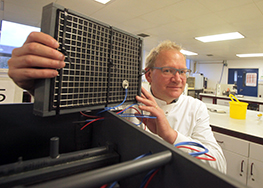China and Norway to be First Petrol-Free Countries
Both China and Norway have pledged to phase out petrol vehicles by 2050. According to new research from commercial vehicle finance company, Asset...
Read Full Article
Turning raw sewage directly into electricity sounds just too good to be true but it’s an area that’s generated a lot of research around the world in recent years. Now, a team from Newcastle University and Northumbrian Water have taken the idea to the next level with a plan to install specially designed microbial electrolysis cells at a water treatment works in Tyneside which should be able to do just that.
Treating wastewater and sewage is an energy-expensive business. It accounts for up to 2% of a developed nation’s annual energy bill but experts estimate that the stored chemical energy contained in sewage could be be as much as nine times greater than the energy cost of processing the stuff.
A fact that water companies, in Europe at least, have not been slow to appreciate. Anaerobic treatment processes where bacteria digest the sewage sludge, turning it into biogas that can burnt to produce electricity or cleaned and fed into the gas grid are now widespread among water authorities, and power plants that use the remaining dried sludge or “cake” as fuel have been around for decades.
But this latest Tyneside twist on turning excrement into energy cuts out the middle-man altogether and uses the raw sewage to generate electricity directly. The process makes use of a naturally ocurring bacteria type – exoelectrogens -- which have evolved to be able to transfer electrons extra-cellularly, which means they “spit out” electrons as they digest the sewage.
By housing these microbial generators on a special carbon felt fitted into frames through which the raw sewage is pumped, then attaching a positive and negative, the microbial electrolysis cell is in business. The bugs get busy digesting the sewage, spitting out electrons as they go to the cell’s positive anode, thereby producing electricity. Meanwhile hydrogen gas, the ultimate green fuel, can be collected from the other end of cell, the cathode, and used for other types of energy production.
Last month, meanwhile, scientists at Stanford University in the US described their own version of a sewage-powered microbial battery and claimed that trial versions could extract up to 30% of the potential energy contained in wastewater.
Article written by Cathryn Ellis | Published 29 November 2013
Both China and Norway have pledged to phase out petrol vehicles by 2050. According to new research from commercial vehicle finance company, Asset...
Read Full ArticleThe Chancellor has presented his Budget to Parliament – here's a summary of what was announced...but we've tried to put it in order of relevance to the FM...
Read Full ArticlePolice and taxis will run on hydrogen in London - and the Met is trialing hydrogen scooters (can't wait for Pizza Hut to do the same). Amey has also put two hydrogen...
Read Full ArticleNew hydrogen additive technology has been claimed to slash engine emissions by up to 80% and increases fuel efficiency by up to 20%. Fitted within the engine bay (on...
Read Full ArticleSavortex, for its IoT and advertising hand dryers and Augean Integrated Services for its food waste service, have both been given Successful Innovator status by...
Read Full ArticleSeven men have been arrested by HM Revenue and Customs (HMRC) and four tonnes of toxic waste removed, after two fuel laundering plants were discovered in Essex on...
Read Full ArticleThe first high pressure grid connected CNG filling station has been unveiled by CNG Fuels and National Grid. The filling station in Leyland, Lancashire, allows...
Read Full ArticleTreasury Minister Damian Hinds visited Belfast and Newry this week as HMRC unveiled new roadside fuel testing equipment to tackle the trade in illicit diesel. The...
Read Full ArticleA ‘safe’ collection system for catering, food and hospitality industries has been launched Fatboxx, from Peter Ridley Waste Systems, is a wheeled...
Read Full Article